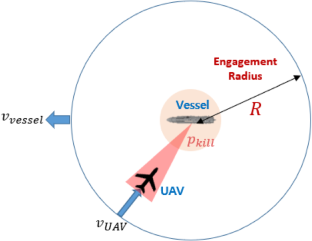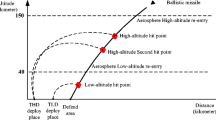Abstract
This paper proposes the engagement model and optimal task assignment algorithm for small-UAV swarm operations in hostile maritime environments. To alleviate the complexity of a real engagement environment, several assumptions are made: in the proposed engagement model, a vessel can attack the UAV within a certain range with a constant kill probability rate; and the ability of a vessel to attack UAVs is reduced if the multiple UAVs are involved. The objective function for optimal task assignment is constructed from the engagement model which estimates the total damage to vessels as the engagement outcome. Considering computational time and non-convex nature of the optimization problem, a heuristic approach, SL-PSO (social-learning particle swarm optimization), is adopted to maximize the objective function. In particular, a modified SL-PSO approach is introduced to deal with the optimization problem in a discrete domain. Numerical simulation results for two scenarios are presented to analyze the characteristics of the proposed engagement model and the performance of the optimal task assignment algorithm in the given environment.












Similar content being viewed by others
References
Otto RP (2016) Small unmanned aircraft systems (SUAS) flight plan: 2016–2036 bridging the gap between tactical and strategic: technical report. Air Force Deputy Chief of Staff, Washington
Edwards SJ (2005) Swarming and the future of warfare, technical report. Rand Corp, Santa Monica
UVision (2019). https://uvisionuav.com/. Accessed May 2019
Switchblade (2019). https://www.avinc.com/uas/adc/switchblade. Accessed May 2019
ALPAGU (2019). https://www.stm.com.tr/en/news/announcement/stm-leaves-its-mark-on-idef-2017. Accessed May 2019
Perdix Project (2019) https://dod.defense.gov/News/News-Releases/News-Release-View/Article/1044811/department-of-defense-announces-successful-micro-drone-demonstration/. Accessed May 2019
McLemore C, Gaver D, Jacobs P (2016) A model for geographically distributed combat interactions of swarming naval and air forces. Naval Res Logist 63(7):562–576
Barkdoll TC, Gaver DP, Glazebrook KD, Jacobs PA, Posadas S (2002) Suppression of enemy air defenses (SEAD) as an information duel. Naval Res Logist NRL 49(8):723–742
Fan DD, Theodorou E, Reeder J (2017) Evolving cost functions for model predictive control of multi-agent UAV combat swarms. In: Proceedings of the genetic and evolutionary computation conference companion, ACM, pp 55–56
Faied M, Assanein I, Girard A (2009) UAVs dynamic mission management in adversarial environments. Int J Aerosp Eng 2009:1–10
Hou Y, Liang X, He L, Zhang J (2019) Time-coordinated control for unmanned aerial vehicle swarm cooperative attack on ground-moving target. IEEE Access 7:106931–106940
Yoo D-W, Lee C-H, Tahk M-J, Choi H-L (2014) Optimal resource management algorithm for unmanned aerial vehicle missions in hostile territories. Proc Inst Mech Eng Part G J Aerosp Eng 228(12):2157–2167
Jia Z, Yu J, Ai X, Xu X, Yang D (2018) Cooperative multiple task assignment problem with stochastic velocities and time windows for heterogeneous unmanned aerial vehicles using a genetic algorithm. Aerosp Sci Technol 76:112–125
Zhen Z, Xing D, Gao C (2018) Cooperative search-attack mission planning for multi-UAV based on intelligent self-organized algorithm. Aerosp Sci Technol 76:402–411
Gao C, Zhen Z, Gong H (2016) A self-organized search and attack algorithm for multiple unmanned aerial vehicles. Aerosp Sci Technol 54:229–240
Li P, Duan H (2017) A potential game approach to multiple UAV cooperative search and surveillance. Aerosp Sci Technol 68:403–415
Manyam SG, Casbeer DW, Manickam S (2017) Optimizing multiple UAV cooperative ground attack missions. In: 2017 International conference on unmanned aircraft systems (ICUAS), IEEE, pp 1572–1578
Bellman R (2013) Dynamic programming. Courier Corporation, Chelmsford
Cheng R, Jin Y (2015) A social learning particle swarm optimization algorithm for scalable optimization. Inf Sci 291:43–60
Eberhart R, Kennedy J (1995) A new optimizer using particle swarm theory. Micro Machine and Human Science, 1995. In: MHS’95. Proceedings of the sixth international symposium on, IEEE, pp 39–43
Kennedy J (2003) Bare bones particle swarms. In: Swarm intelligence symposium. Proceedings of the 2003 IEEE, IEEE, pp 80–87
Kennedy J, Mendes R (2002) Population structure and particle swarm performance. Evolutionary computation. In: Proceedings of the 2002 congress on vol 2, IEEE, pp 1671–1676
Hsieh S-T, Sun T-Y, Liu C-C, Tsai S-J (2009) Efficient population utilization strategy for particle swarm optimizer. IEEE Trans Syst Man Cybern Part B (Cybern) 39(2):444–456
Gong Y-J, Li J-J, Zhou Y, Li Y, Chung HS-H, Shi Y-H, Zhang J (2016) Genetic learning particle swarm optimization. IEEE Trans Cybern 46(10):2277–2290
Pham LV, Dickerson B, Sanders J, Casserly M, Maldonado V, Balbuena D, Graves S, Pandya B (2012) UAV swarm attack: protection system alternatives for destroyers. Ph.D. thesis, Monterey, California: Naval Postgraduate School
Metz S (2000) Armed conflict in the 21st century: the information revolution and post-modern warfare. Strategic Studies Institute, London
Jadoun VK, Gupta N, Niazi K, Swarnkar A (2014) Nonconvex economic dispatch using particle swarm optimization with time varying operators. Adv Electr Eng 2014:1–13
Acknowledgements
This research has been supported by the Defense Challengeable Future Technology Program of Agency for Defense Development, Republic of Korea, Basic Science Research Program through the National Research Foundation of Korea (NRF) funded by the Ministry of Education (2020R1A6A1A03040570), and a grant to Bio-Mimetic Robot Research Center Funded by Defense Acquisition Program Administration and Agency for Defense Development, Republic of Korea (UD190018ID).
Author information
Authors and Affiliations
Corresponding author
Additional information
Publisher's Note
Springer Nature remains neutral with regard to jurisdictional claims in published maps and institutional affiliations.
Rights and permissions
About this article
Cite this article
Kim, J., Oh, H., Yu, B. et al. Optimal Task Assignment for UAV Swarm Operations in Hostile Environments. Int. J. Aeronaut. Space Sci. 22, 456–467 (2021). https://doi.org/10.1007/s42405-020-00317-z
Received:
Revised:
Accepted:
Published:
Issue Date:
DOI: https://doi.org/10.1007/s42405-020-00317-z




